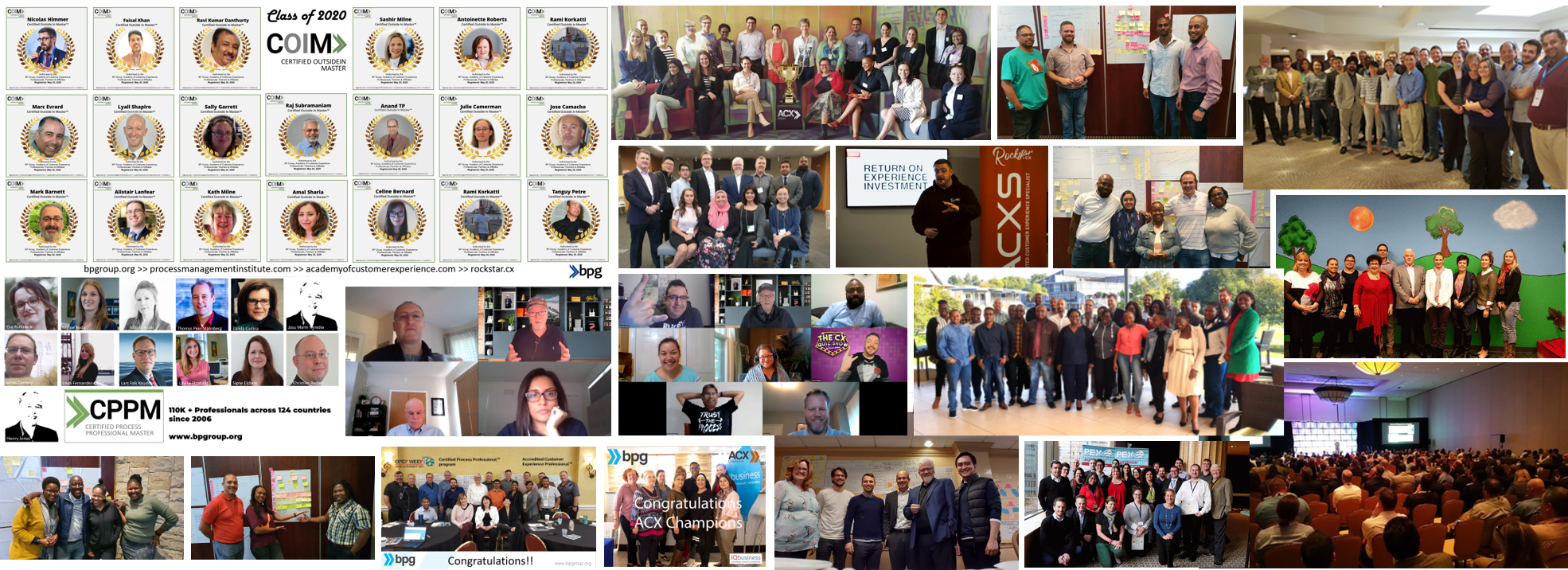CERTIFIED JOURNEY MANAGEMENT PROFESSIONAL



PROFESSIONAL QUALIFICATIONS SINCE 1992

IT IS LIVE & INTERACTIVE
A nice testimonial!
More than 140,000 professionals
across 137 countries have completed qualifications with the BP Group and its affiliates since 1992.
across 137 countries have completed qualifications with the BP Group and its affiliates since 1992.
Our programs carry the very latest content 'next practices' from the best performing companies and people
on the planet.
on the planet.
HANDS-ON PRAGMATIC AND BANG UP TODATE
ONLINE, LIVE, INTERACTIVE
We offer Open and Inhouse programs ranging from 1 day to 7 weeks from CJM beginner to Master to Champion to Mentor.
AGENDA OUTLINE
DAY 1:
Why Customer Journey Management?
Customer journey management and customer journey mapping are two distinct concepts, but they can both be used to improve customer experience and engagement.
Customer journey management is a holistic approach to customer experience. It looks at the entire customer journey, from initial contact to post-sale service, and tries to identify areas where customer experience can be improved. By understanding the customer experience, businesses can create targeted strategies to help boost customer satisfaction and loyalty.
Customer journey mapping is a more targeted approach to customer experience. It focuses on the individual customer’s journey, rather than the entire journey. It enables businesses to visualize the customer’s experience and identify the areas where they can benefit from improvement. By understanding the customer’s individual journey, businesses can create strategies that are tailored to specific customer needs.
Both customer journey management and customer journey mapping are essential tools for businesses that want to improve customer experience and optimize resources. They help identify areas of improvement and develop strategies that can help to increase customer satisfaction and loyalty.
Successful Outcome 1: The delegate can provides support and direction to the organisation regarding the deployment of a Customer Journey Management
Why Customer Journey Management?
Customer Journey Management (CJM) is an approach to understanding and improving the customer experience. It is an outside-in, outcomes-based approach to managing customer journeys. It is an orchestration of touchpoints across channels, functions, and departments to create the best possible customer experience. CJM allows companies to identify and address customer needs, create better customer experiences, and increase customer loyalty.
• What is a customer journey?
• What are the different levels of customer journeys?
• What is journey mapping?
• What is Customer Journey Management?
• What are the differences between Customer Journey Management and customer journey mapping?
Customer journey management and customer journey mapping are two distinct concepts, but they can both be used to improve customer experience and engagement.
Customer journey management is a holistic approach to customer experience. It looks at the entire customer journey, from initial contact to post-sale service, and tries to identify areas where customer experience can be improved. By understanding the customer experience, businesses can create targeted strategies to help boost customer satisfaction and loyalty.
Customer journey mapping is a more targeted approach to customer experience. It focuses on the individual customer’s journey, rather than the entire journey. It enables businesses to visualize the customer’s experience and identify the areas where they can benefit from improvement. By understanding the customer’s individual journey, businesses can create strategies that are tailored to specific customer needs.
Both customer journey management and customer journey mapping are essential tools for businesses that want to improve customer experience and optimize resources. They help identify areas of improvement and develop strategies that can help to increase customer satisfaction and loyalty.
• What are the benefits of Customer Journey Management?
• What are the potential pitfalls of CJM?
• What is CJMP’s role in Customer Journey Management?
• What is Customer Journey Orchestration?
• What are the software tools that can support Customer Journey Management?
• Q&A
DAY 2:
Customer Journey Management – The How, Where, and When
Customer Journey Management – The How, Where, and When
Successful Outcome 1: The delegate can provides support and direction to the organisation regarding the deployment of a Customer Journey Management
• Where is CJM being used - geography, industry, and structurally?
• How CJM can be deployed (including customer journey orchestration)
• Who has implemented successful CJM programmes? (8-10 mini-case studies)
• How has CJM been integrated and aligned with other business initiatives?
• What is the magnitude and timescale of the success achieved?
• How quickly could you pragmatically deploy CJM (including Capabilities, Alignment and Results)
• Q&A
Successful Outcome 2: The delegate is introduced to the CJM+ CEMMethod toolkit
• Customer Journey Management tools, techniques, tips, and hacks
• How can the CEMMethod help?
The approach is a powerful tool for transforming businesses, allowing them to become more customer-centric and focused on providing the best possible customer experiences. The CEMMethod approach consists of five key benefits:
1. Improved customer insights: By understanding the customer journey, businesses can gain valuable insights into customer preferences, behaviors, and experiences. This can help them to tailor their offerings and services to better meet customer needs.
2. Increased customer engagement: By using the CEMMethod approach, businesses can create more engaging and personalized customer experiences that will keep customers coming back.
3. Enhanced customer loyalty: By understanding the needs of their customers and providing experiences that meet those needs, businesses can increase customer loyalty and create lifelong customers.
4. Improved bottom line: By focusing on customer needs and creating engaging experiences, businesses can drive revenue and profits.
5. Delivery of the Triple Crown: The triple crown is a way of simultaneously growing revenues, reducing costs, and improving customer satisfaction. By utilizing the CEMMethod approach, businesses can identify opportunities for cost reductions and create experiences that will increase revenues, thereby achieving the triple crown.
Overall, the CEMMethod approach is a powerful tool for transforming businesses and making them more customer-centric. It can help businesses to better understand their customers, create more engaging experiences, drive customer loyalty, and improve their bottom line.
• Practical use of the toolkit (90 minutes hands-on)
• CJM Dashboarding
• Q&A
In summary...
Overall, Customer Journey MANAGEMENT is focused on providing a complete customer-centric experience that focuses on the entire life cycle of the customer, while customer journey mapping is focused on visualizing part of the customer’s journey to identify any areas of improvement. Understanding and optimising the differences between these two processes can help businesses create better customer experiences, increase customer loyalty, and improve their bottom line.

Study from your space and participate in exercises, real life case studies and 2023 thinking and practices. You can even bring your own challenges and we will work them together.
Following the sessions we will meet in one to ones to review your progress.
Following the sessions we will meet in one to ones to review your progress.
A year after training in London just wanted to shoot a note of my continued gratitude. Hope to remain involved in the events and work with you again.. that mentoring was beyond invaluable.
Juliana Coates, Member Services,
University of Albany, New York
LIVE
Available to attend LIVE so there is a fun learning environment customised to the needs of the people in the training. Each session is also recorded for your online viewing later. Your experience will change the way you think and work forever.
Thanks very much for an amazing course! You are a fantastic facilitator and I'm truly blessed to have you share your wisdom with us.
Jenny Simpson, Associate Director,
National Australia Bank, Sydney, Australia

INTERACTIVE
With plenty of opportunity for Questions and Answers we will navigate the sessions in a proactive and pragmatic way. Outside of the main sessions we host live webinars to reinforce learning. Validation for the qualification comes through completing subsequent exercises that are again managed on a one to one basis.
"I was struck with awe on the versatile yet practical experience that you shared. Thanks for the wonderful session on CPP this week“
Syed Raashid, Specialist,
RasGas Co Ltd. UAE
MORE TESTIMONIALS









